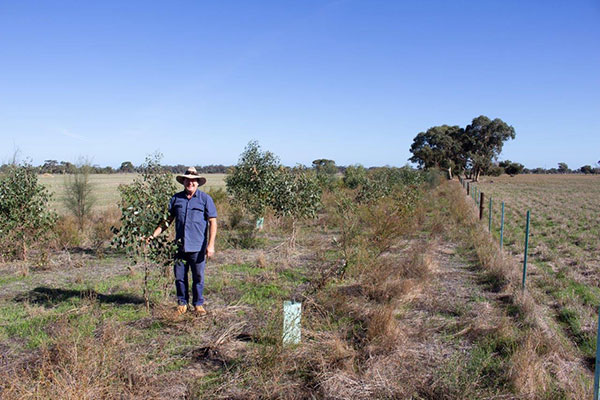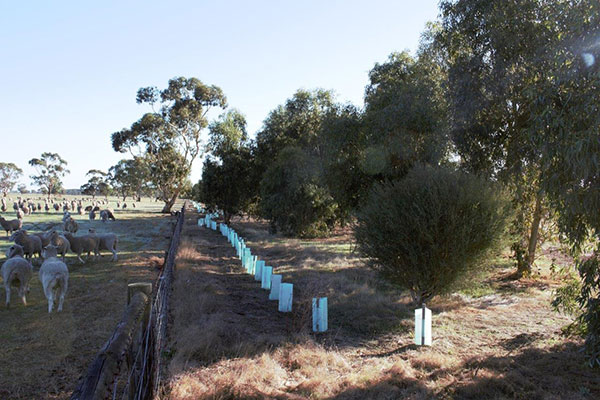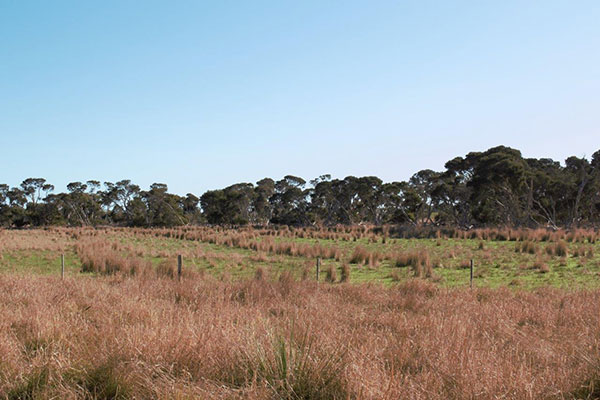Name:
Graham Clothier
Location:
‘Greenvale’ Woolumbool, South East, South Australia
Average Rainfall:
385mm
Enterprises:
3500 ewes (1500 merinos 2000 crossbreds) + 2000 hens
Farm Area:
650 hectares
Planting shelter belts was always a “job for later on” according to Graham Clothier. Inspired by the impressive establishment of his neighbour’s trees and having heard the science behind their role in lambs alive, he started planting. Exposure is one of the four major causes of perinatal deaths in lambs and provision of shelter against the wind can help to minimise its impact.
Research by EverGraze has determined that very strong winds can drop the apparent temperature by 20°C. At their Hamilton (Victoria) trial site, shelterbelts reduced wind speed by up to 99%, compared with the unsheltered areas.
As a result, lambs alive increased by 30% in these sheltered areas, while other studies have shown a 50% increase in Merino twin lambs alive in sheltered paddocks. Further research has demonstrated that shelterbelts are particularly effective in improving lambs alive of twins and triplet lambs (11-15% increase) as their lower birth weight makes them more susceptible to exposure.
Graham’s observations on his own property support this positive improvement in lamb survival due to improved shelter.

Graham photographed in one of his shelterbelts planted to minimise the impacts of exposure to his lambs.

Shelter belts, with shrubs planted as tube stock
Graham has progressively planted shelter belts across his property. The belts are native trees (directly seeded) and shrubs (tube stock) suited to the soil type and location in the landscape, including stringy barks, red gums and banksias. The aim is to plant them close together to act as a protective barrier and far enough apart so the density of foliage doesn’t completely block the wind flow. The height of the trees and shrubs planted determines the buffer zone of protection.
Graham is happy with the progress of the trees and shrubs, which have self-propagated in some areas, and has learned from his experience; “it is important to think about the water requirements for the first two years while the trees are establishing themselves.
Without rain, people should really be thinking about watering their tree lines.” Additionally, he warns that the water requirements of established trees can be detrimental to the growth of the seedlings, with the majority of seedlings within close proximity to an established tree dying off.
"The best time to plant a tree was 20 years ago. The second best time is now." - Chinese Proverb
In addition to improved numbers of lambs alive, the shelter belts have been positively incorporated into Graham’s egg enterprise, adding that his chooks “love to fossick around in [the tree lines] for insects.” The shelter belts act as a sanctuary for insects and other fauna to thrive, and acts as a biodiversity corridor for birds. Graham notes “the birds around the place are prolific.” While the belts have improved biodiversity, Graham has not seen any increase in vermin, namely foxes, as a result of planting and fencing off the trees.
Is it worth the time and effort? “There’s the loss of grazing land and the initial cost… but the benefits more than outweigh the cost.” Graham initially sought grants for establishment of the shelter belts and engaged a local revegetation contractor, as well as school groups to plant the trees and shrubs. Maintenance once the belts are established is minimal. Graham has fenced off all the shelter belts with hot wires to keep his stock out.
The land is re-purposed and being the insightful, forward thinking farmer he is, Graham has considered a succession plan for the belts – “it won’t be in my lifetime, but we’ve planted trees that can be used for their timber, for furniture…and we trim down the lower two thirds of the hard wood trees for that [purpose].” While fenced-off belts of trees are less susceptible (than single trees in a paddock) to the negative effects of sheep camping under them, it does raise the consideration of the lifetime of the belts and whether replanting is a necessary activity.
The shrubs will remain as effective shelter, albeit the buffer zone will be decreased by removing the trees for timber.
In addition to the belts of trees and shrubs, Graham has also sown tall wheat grass strips, for the same purpose – to provide shelter for lambing ewes. The added bonus is the grazing benefit. Since the tall wheat grass was sown, clear rows of tussocks have matured, despite some not reaching tussock-maturity due to early grazing. Graham anticipates later management being spot spraying over time (thinning) as the grass encroaches on the open space.

Tall wheat grass strips provide shelter for lambing ewes
Prepared by Claire Dennerley, Primary Industries and Regions SA: Rural Solutions SA (2018).
Print Case Study
This project is supported by AWI, Primary Industries and Regions SA and SA Sheep Industry Fund.
